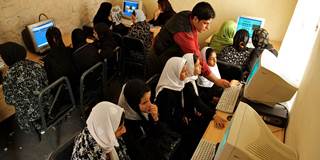Women’s access to the Internet and mobile phones is about 85% of the level for men, on average, and a total of 1.7 billion women in low- and middle-income countries are unconnected. Closing these gaps would enable women to seize opportunities in the industries that are shaping our collective future, benefiting all.
MONTREAL – Digital technologies are a double-edged sword for the world’s women. Men’s greater access to these technologies puts women at risk of being left even further behind economically and socially. But if women can tap the full power of digital technologies, vital new opportunities will open up for them.
According to estimates by the GSM Association, women’s access to the Internet and mobile phones is about 85% of the level for men, on average, and a total of 1.7 billion women in low- and middle-income countries are unconnected. This severely limits the prospects of women and girls.
Digital technologies enhance women’s access to finance, with mobile banking enabling them to avoid long journeys to a branch or ATM. Likewise, technology-enabled health care delivered via phone or tablet improves health outcomes, as it reaches women even in the remotest areas, sparing them a long and often risky trek to see a doctor.

MONTREAL – Digital technologies are a double-edged sword for the world’s women. Men’s greater access to these technologies puts women at risk of being left even further behind economically and socially. But if women can tap the full power of digital technologies, vital new opportunities will open up for them.
According to estimates by the GSM Association, women’s access to the Internet and mobile phones is about 85% of the level for men, on average, and a total of 1.7 billion women in low- and middle-income countries are unconnected. This severely limits the prospects of women and girls.
Digital technologies enhance women’s access to finance, with mobile banking enabling them to avoid long journeys to a branch or ATM. Likewise, technology-enabled health care delivered via phone or tablet improves health outcomes, as it reaches women even in the remotest areas, sparing them a long and often risky trek to see a doctor.